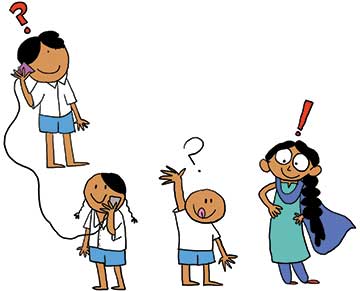Vijay Gupta
Let me share with you a typical scenario in our classrooms. The teacher has been teaching the algorithm of division, and then asks students to calculate 212 divided by 2. Rahul gets the answer 16 and excitedly shares it with the teacher. The teacher shuts him down saying he is wrong. Rahul took the risk of sharing his answer and got a snub. Sooner or later Rahul is likely to convince himself that he can’t learn math.
In our work with teachers, across India, over more than a decade, we repeatedly come across this kind of classroom interaction. We believe that such a classroom environment is not conducive for deep learning. Making mistakes, and learning from them, is an essential part of the learning journey. This will not happen in a classroom environment where students think twice before sharing their answer, or explore one more way of solving a problem, or engage with one more aspect of a situation.
 If you agree with me so far, this article will share with you six ways in which we can start creating an environment where students take a risk, where they look at mistakes as one more opportunity for learning, and are not satisfied with one way of attacking a problem, and also engage in finding out the answer rather than wait for the teacher to give the answer.
If you agree with me so far, this article will share with you six ways in which we can start creating an environment where students take a risk, where they look at mistakes as one more opportunity for learning, and are not satisfied with one way of attacking a problem, and also engage in finding out the answer rather than wait for the teacher to give the answer.
One, when students respond to a question, do not get busy with whether the answer is right or wrong. A better line of thought is to say – “Let us examine this answer”, and encourage the student to share how he went about figuring out the answer. This should be done irrespective of whether the answer is right or wrong. For our earlier division problem, let Rahul share how he applied the division algorithm and encourage him, and the entire class, to think if the answer seems sensible.
As you can see, this division problem is a great opportunity to explain how the division algorithm works. In the first step, when we say divide first ‘2’ of 212 by 2 and get 1, actually what we have done is that we have divided 200 by 2 and have got hundred (that is, 1 in the hundredth place). In the second step, we are actually dividing 10 by 2, and should get 5 but the algorithm is so efficient that it figures out that there is a zero in the tenth place and encourages us to divide 12 by 2 to get 6 in the unit place.
In addition, we can encourage students to examine if the answer 16 is looking sensible! That is, how can a number, which is more than 200, when divided by 2 be less than 100? By not getting busy with whether the answer was right or wrong, we have encouraged students to take the risk of sharing the answer, and have taken the opportunity of a wrong answer to deepen their understanding of the division algorithm.
Two, encourage students to engage in figuring out the answer instead of giving answers, or explanations. For example, supposing we are teaching the concept of the water cycle. Instead of describing the water cycle in terms of evaporation, cloud formation, condensation and precipitation, is it possible to pose a question like this – have you wondered where the water, when it rains, comes from? Get students to work in small groups to list down their explanations (hypotheses). This might include such hypothesis as God is sitting with huge tanks of water! Like we mentioned earlier, no explanation is right or wrong – we would rather examine each one to find out which hypothesis explains the question the best.
The teacher, therefore, keeps pushing students by posing questions like where does God get that water and then gives the explanation of the water cycle. This way of learning is deep since students are taking the risk of going into unchartered territory and in the process learning how a scientist works.
Three, encourage students to ask questions. Typically, in our classrooms all the questions are asked by the teacher and students are only responding to these questions. This might be happening for two reasons – one, past experience of asking questions has convinced students that asking questions is risky – you never know when other students will laugh at their question, or the teacher might embarrass them by saying it is a “silly question”. And two, we don’t give time to students to form and raise their questions.
The best way to change such a situation is to stop teaching from time to time, and ask students if there are any questions. Initially, there will be a total silence, but you should not give up. As you can see, changing the classroom environment that has been created over the years will take some time. And, of course, give the message that no question is silly, or to be laughed at!
 Four, always discuss alternative ways of solving a problem, or alternative points of view. For example, in a math class, after showing one way of solving a problem, get students to work in small groups of 3-4 and ask them to figure out another way of solving the problem. Some students will always figure out another route, or else we show them another way. By doing this we are making them comfortable with the idea that learning is not one-dimensional, or linear, but can take a variety of paths.
Four, always discuss alternative ways of solving a problem, or alternative points of view. For example, in a math class, after showing one way of solving a problem, get students to work in small groups of 3-4 and ask them to figure out another way of solving the problem. Some students will always figure out another route, or else we show them another way. By doing this we are making them comfortable with the idea that learning is not one-dimensional, or linear, but can take a variety of paths.
Five, deliberately make mistakes, and show them how to recover from them. Discuss with students how every failure is actually offering us an opportunity for learning, that is, learning how not to make such a mistake. I remember Thomas Alva Edison famously saying – when I failed 99 times out of 100 attempts, I learnt 99 ways that won’t work! For example, deliberately use a wrong strategy to solve a problem, or form incorrect sentences, or incorrect spellings, or a flawed argument, and show them how to first recognize a mistake and recover from it.
Lastly, when students do well, don’t tell them that they are smart, or bright, but say you must have put in great effort to turn out such a good work; similarly, when they turn in poor output, don’t say that they are dull, or slow, but that you haven’t put much effort and that is why the outcomes are not good. This essentially means that we are praising the effort and not the outcome. When we tell students they are smart, their willingness to take risk goes down as they don’t want their self-image of “smart” to suffer if they mess up things. Similarly, when we tell some students that they are “not smart”, they give up trying.
This idea has been well researched and documented by Carol Dweck and she gives it the label of “growth mind-set”, that is, I can do better if I put in more effort, versus “fixed mind-set” which says that I can never learn whatever I do, and therefore there is no point in putting in effort.
 All the six strategies, if practised consistently, will create a classroom environment where students are engaging in exploration, experimentation, trying out new ways, etc., without any anxiety of being embarrassed or put down. This is the right environment for facilitating deep learning. The opposite of this is being anxious to always be correct, and therefore don’t even try so that no one can fault us. The latter will create rote learners who will only mouth rote learnt definitions.
All the six strategies, if practised consistently, will create a classroom environment where students are engaging in exploration, experimentation, trying out new ways, etc., without any anxiety of being embarrassed or put down. This is the right environment for facilitating deep learning. The opposite of this is being anxious to always be correct, and therefore don’t even try so that no one can fault us. The latter will create rote learners who will only mouth rote learnt definitions.
Our challenge will be to find the time to let students explore, raise questions, try out new ways, etc., even as we have the pressure of completing the syllabus. My response to this challenge is three-fold:
One, when we create an environment of exploration and risk taking, students take greater charge of their learning, and therefore the teacher can pass on more responsibility of learning to the students, which means that we can move faster on our syllabus.
Two, when learning is deep we can absorb the next concept or skill, faster, which again means that we can move faster.
Three, as you can see, this environment is very engaging for students. When students are engaged, there is less possibility of classroom disorderliness, and therefore, there is less loss of teaching time.
Therefore, I believe that using these six strategies will not slow you down. If you are still not convinced, then consider this: what is the point of finishing the syllabus when only a few students have absorbed the learning?
The author is co-founder and director, Shikshangan Education Initiatives, Pune. Shikshangan has been helping schools across India to raise the quality of learning for every child for the past ten years. He can be reached at vijay@shikshangan.org.
Related Articles
Embracing risk and uncertainty
Of gender identity, self-determination and preferred pronouns
